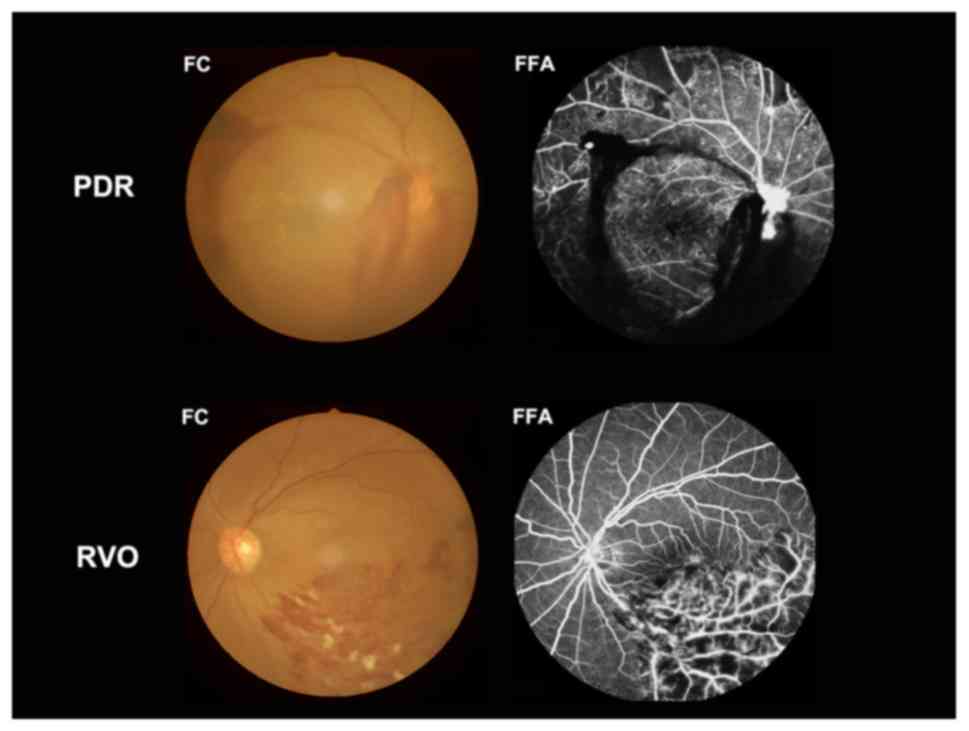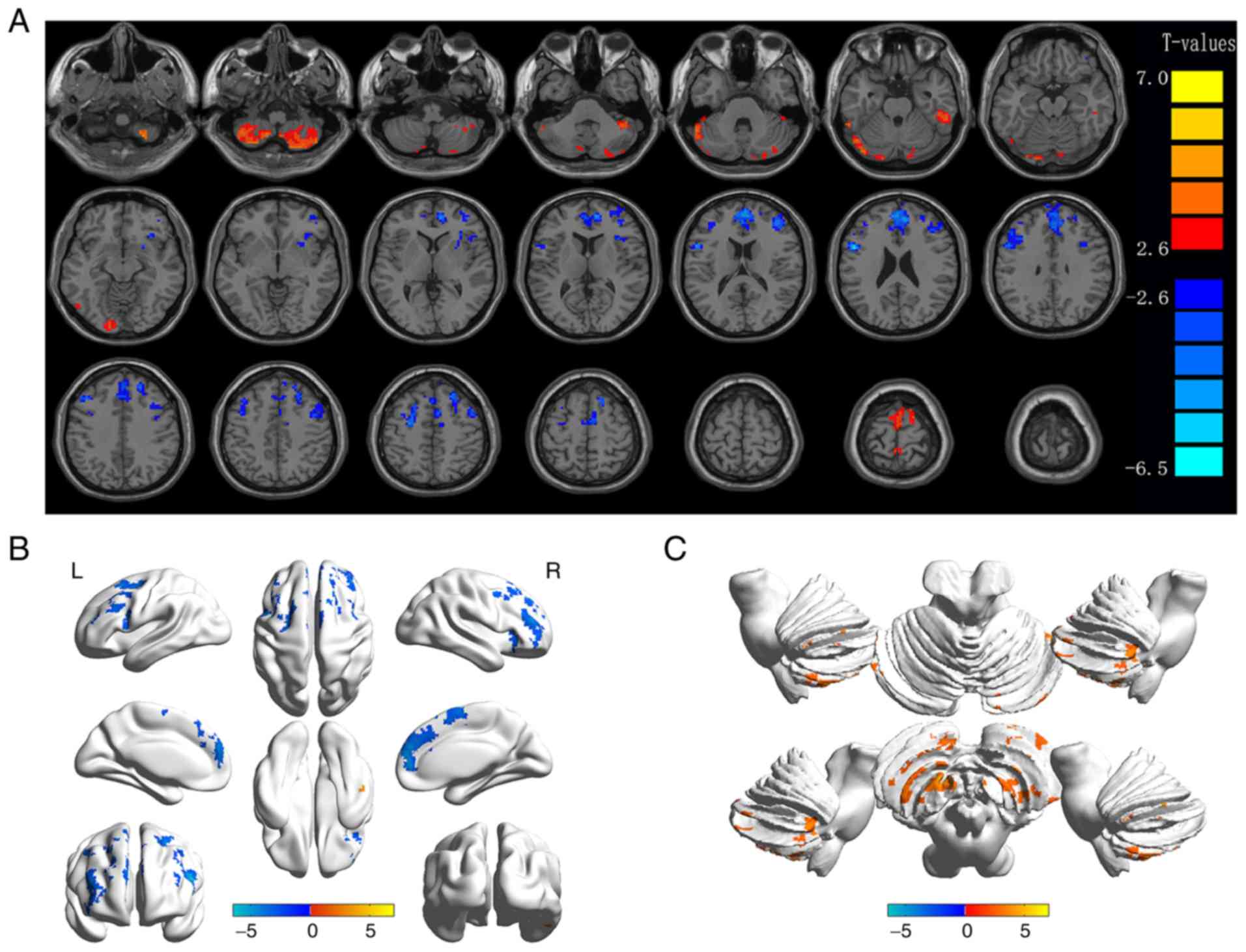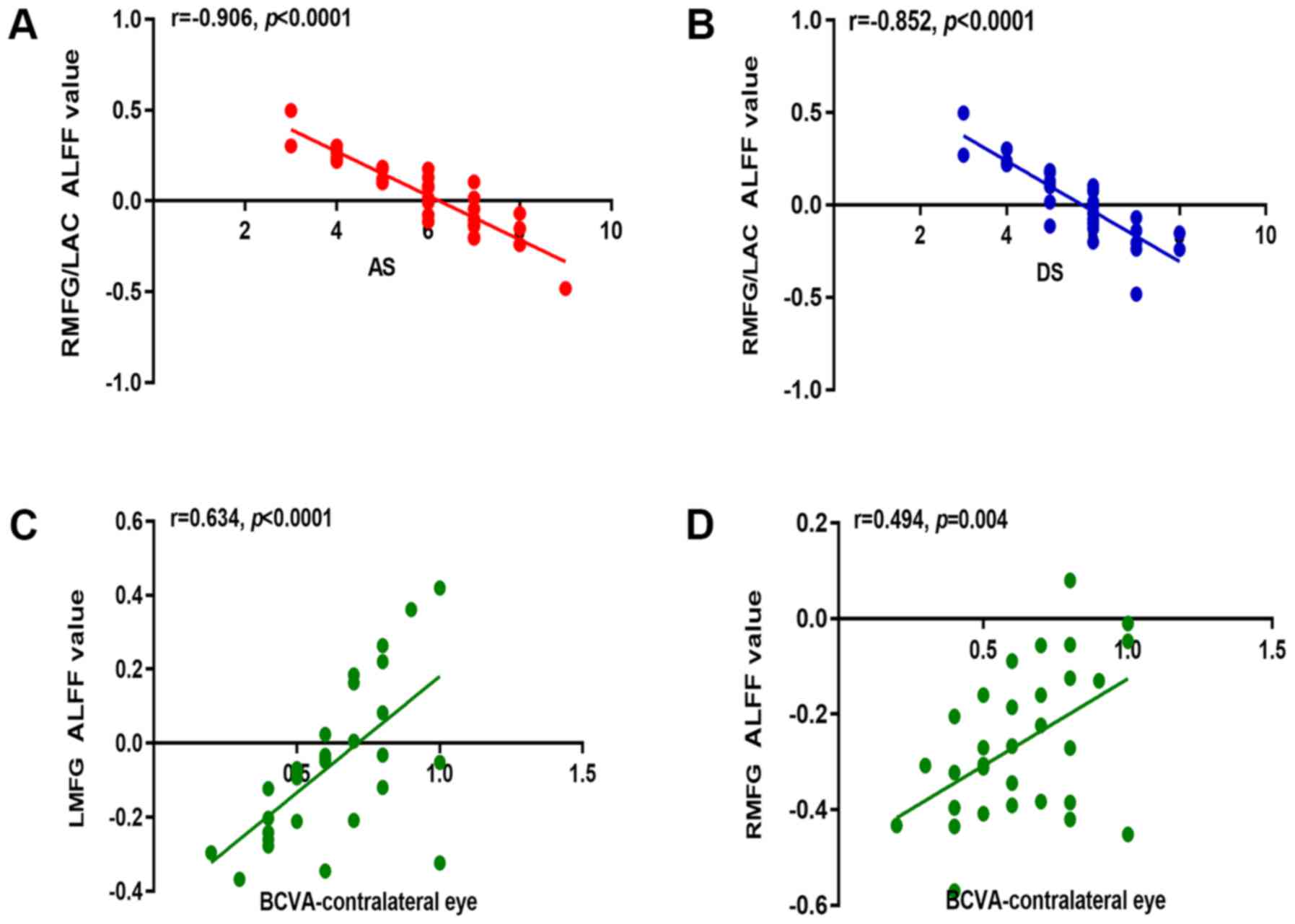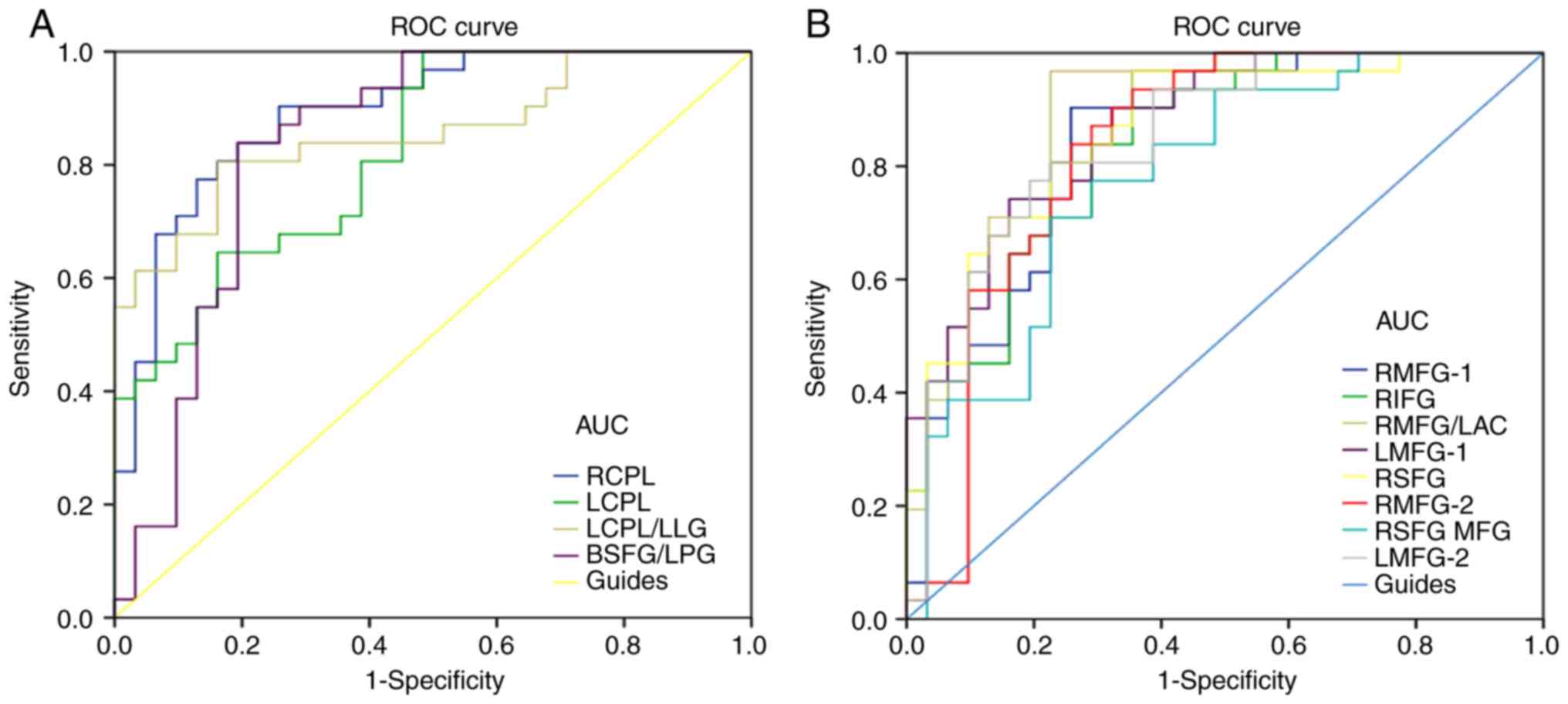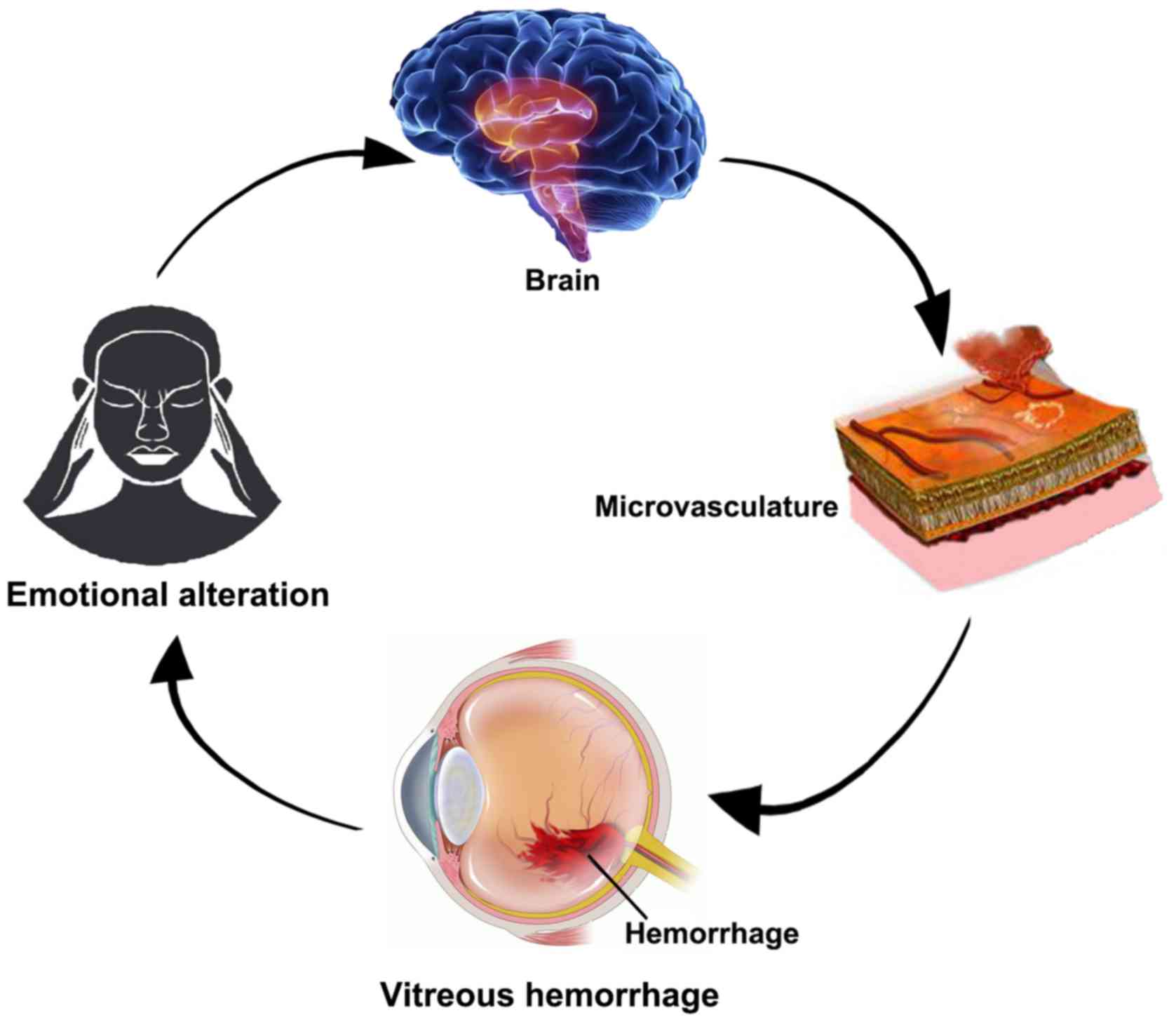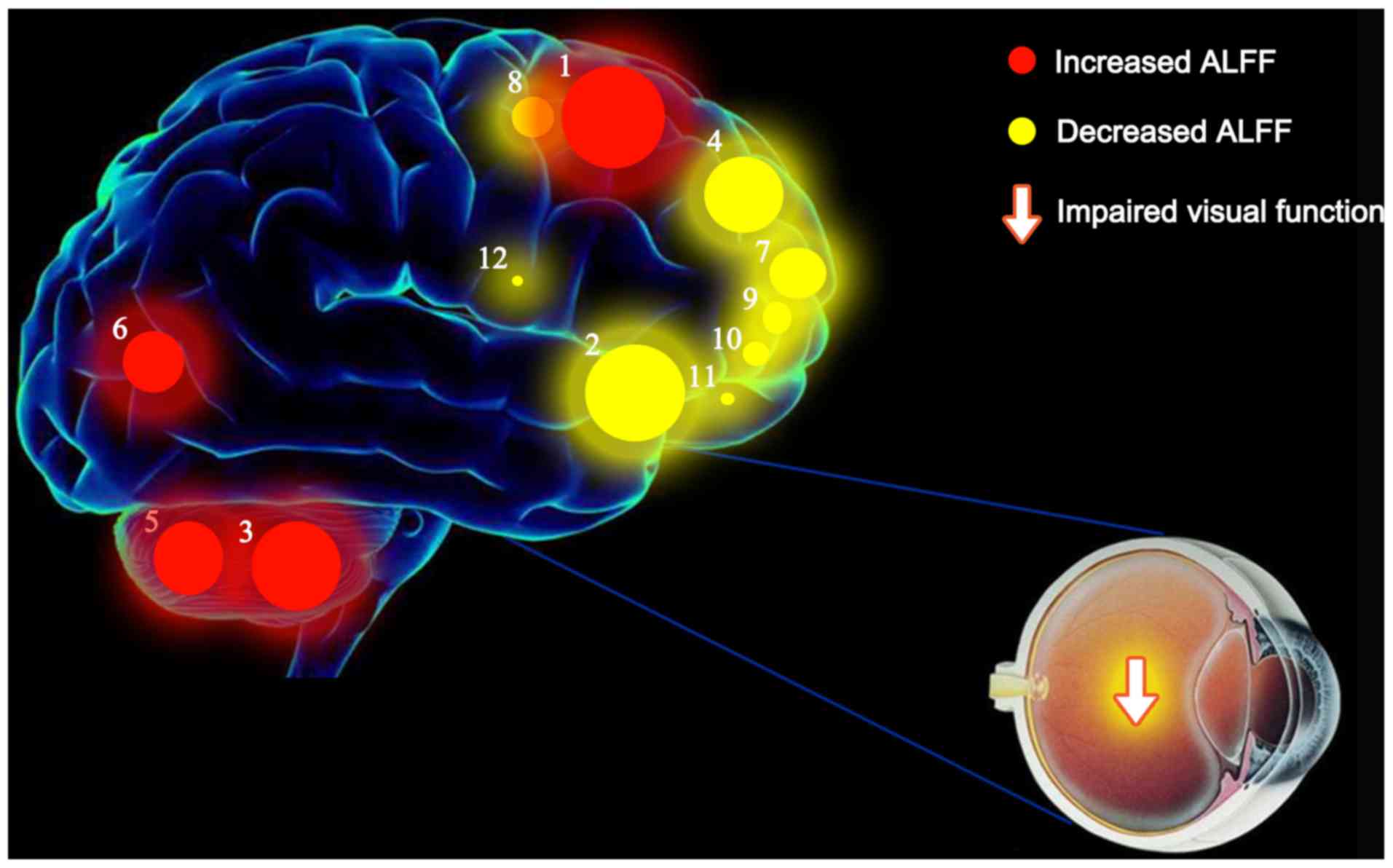|
1
|
Shaw JE, Sicree RA and Zimmet PZ: Global
estimates of the prevalence of diabetes for 2010 and 2030. Diabetes
Res Clin Pract. 87:4–14. 2010. View Article : Google Scholar : PubMed/NCBI
|
|
2
|
Ong SR, Crowston JG, Loprinzi PD and
Ramulu PY: Physical activity, visual impairment, and eye disease.
Eye (Lond). 32:1296–1303. 2018. View Article : Google Scholar : PubMed/NCBI
|
|
3
|
Spraul CW and Grossniklaus HE: Vitreous
hemorrhage. Surv Ophthalmol. 42:3–39. 1997. View Article : Google Scholar : PubMed/NCBI
|
|
4
|
Yoonessi R, Hussain A and Jang TB: Bedside
ocular ultrasound for the detection of retinal detachment in the
emergency department. Acad Emerg Med. 17:913–917. 2010. View Article : Google Scholar : PubMed/NCBI
|
|
5
|
Cuevas P, Outeirino LA, Azanza C, Angulo J
and Gimenez- Gallego G: Dramatic resolution of vitreous hemorrhage
after an intravitreal injection of dobesilate. Mil Med Res.
2:232015.PubMed/NCBI
|
|
6
|
Brown HD, Woodall RL, Kitching RE, Baseler
HA and Morland AB: Using magnetic resonance imaging to assess
visual deficits: A review. Ophthalmic Physiol Opt. 36:240–265.
2016. View Article : Google Scholar : PubMed/NCBI
|
|
7
|
Katwal SB, Gore JC, Gatenby JC and Rogers
BP: Measuring relative timings of brain activities using fMRI.
NeuroImage. 66:436–448. 2013. View Article : Google Scholar : PubMed/NCBI
|
|
8
|
Conner IP, Odom JV, Schwartz TL and
Mendola JD: Monocular activation of V1 and V2 in amblyopic adults
measured with functional magnetic resonance imaging. J AAPOS.
11:341–350. 2007. View Article : Google Scholar : PubMed/NCBI
|
|
9
|
Min YL, Su T, Shu YQ, Liu WF, Chen LL, Shi
WQ, Jiang N, Zhu PW, Yuan Q, Xu XW, et al: Altered spontaneous
brain activity patterns in strabismus with amblyopia patients using
amplitude of low-frequency fluctuation: A resting-state fMRI study.
Neuropsychiatr Dis Treat. 14:2351–2359. 2018. View Article : Google Scholar : PubMed/NCBI
|
|
10
|
Zuo XN, Di Martino A, Kelly C, Shehzad ZE,
Gee DG, Klein DF, Castellanos FX, Biswal BB and Milham MP: The
oscillating brain: Complex and reliable. Neuroimage. 49:1432–1445.
2010. View Article : Google Scholar : PubMed/NCBI
|
|
11
|
Kang HH, Shu YQ, Yang L, Zhu PW, Li D, Li
QH, Min YL, Ye L, Zhou Q and Shao Y: Measuring abnormal intrinsic
brain activities in patients with retinal detachment using
amplitude of low-frequency fluctuation: A resting-state fMRI study.
Int J Neurosci. 129:681–686. 2019. View Article : Google Scholar : PubMed/NCBI
|
|
12
|
Pan ZM, Li HJ, Bao J, Jiang N, Yuan Q,
Freeberg S, Zhu PW, Ye L, Ma MY, Huang X and Shao Y: Altered
intrinsic brain activities in patients with acute eye pain using
amplitude of low-frequency fluctuation: A resting-state fMRI study.
Neuropsychiatr Dis Treat. 14:251–257. 2018. View Article : Google Scholar : PubMed/NCBI
|
|
13
|
Huang X, Zhong YL, Zeng XJ, Zhou F, Liu
XH, Hu PH, Pei CG, Shao Y and Dai XJ: Disturbed spontaneous brain
activity pattern in patients with primary angle-closure glaucoma
using amplitude of low-frequency fluctuation: A fMRI study.
Neuropsychiatr Dis Treat. 11:1877–1883. 2015.PubMed/NCBI
|
|
14
|
Zung WW: A self-rating depression scale.
Arch Gen Psychiatry. 12:63–70. 1965. View Article : Google Scholar : PubMed/NCBI
|
|
15
|
Hamilton M: The assessment of anxiety
states by rating. Br J Med Psychol. 32:50–55. 1959. View Article : Google Scholar : PubMed/NCBI
|
|
16
|
Zigmond AS and Snaith RP: The hospital
anxiety and depression scale. Acta Psychiatr Scand. 67:361–370.
1983. View Article : Google Scholar : PubMed/NCBI
|
|
17
|
Huang X, Cai FQ, Hu PH, Zhong YL, Zhang Y,
Wei R, Pei CG, Zhou FQ and Shao Y: Disturbed spontaneous
brain-activity pattern in patients with optic neuritis using
amplitude of low-frequency fluctuation: A functional magnetic
resonance imaging study. Neuropsychiatr Dis Treat. 11:3075–3083.
2015.PubMed/NCBI
|
|
18
|
Evans AC, Janke AL, Collins DL and Baillet
S: Brain templates and atlases. Neuroimage. 62:911–922. 2012.
View Article : Google Scholar : PubMed/NCBI
|
|
19
|
Chang J and Yu R: Acute social stress
modulates coherence regional homogeneity. Brain Imaging Behav.
13:762–770. 2019. View Article : Google Scholar : PubMed/NCBI
|
|
20
|
Farnarier G, Sobrepere G and Croisy A:
Syndrome of hematoma of the vitreous body with Terson's spontaneous
intracranial hemorrhage. Bull Soc Ophtalmol Fr. 8:556–560. 1955.(In
French).
|
|
21
|
Bandettini PA: Twenty years of functional
MRI: The science and the stories. NeuroImage. 62:575–588. 2012.
View Article : Google Scholar : PubMed/NCBI
|
|
22
|
Zang YF, He Y, Zhu CZ, Cao QJ, Sui MQ,
Liang M, Tian LX, Jiang TZ and Wang YF: Altered baseline brain
activity in children with ADHD revealed by resting-state functional
MRI. Brain Dev. 29:83–91. 2007. View Article : Google Scholar : PubMed/NCBI
|
|
23
|
Li Q, Huang X, Ye L, Wei R, Zhang Y, Zhong
YL, Jiang N and Shao Y: Altered spontaneous brain activity pattern
in patients with late monocular blindness in middle-age using
amplitude of low-frequency fluctuation: A resting-state functional
MRI study. Clin Interv Aging. 11:1773–1780. 2016. View Article : Google Scholar : PubMed/NCBI
|
|
24
|
Stoodley CJ and Schmahmann JD: Functional
topography of the human cerebellum. Handb Clin Neurol. 154:59–70.
2018. View Article : Google Scholar : PubMed/NCBI
|
|
25
|
Paulin MG: The role of the cerebellum in
motor control and perception. Brain Behav Evol. 41:39–50. 1993.
View Article : Google Scholar : PubMed/NCBI
|
|
26
|
Casula EP, Pellicciari MC, Ponzo V,
Stampanoni Bassi M, Veniero D, Caltagirone C and Koch G: Cerebellar
theta burst stimulation modulates the neural activity of
interconnected parietal and motor areas. Sci Rep. 6:361912016.
View Article : Google Scholar : PubMed/NCBI
|
|
27
|
Stoodley CJ and Schmahmann JD: Functional
topography in the human cerebellum: A meta-analysis of neuroimaging
studies. Neuroimage. 44:489–501. 2009. View Article : Google Scholar : PubMed/NCBI
|
|
28
|
Schienle A and Scharmuller W: Cerebellar
activity and connectivity during the experience of disgust and
happiness. Neuroscience. 246:375–381. 2013. View Article : Google Scholar : PubMed/NCBI
|
|
29
|
Hayakawa Y, Nakajima T, Takagi M, Fukuhara
N and Abe H: Human cerebellar activation in relation to saccadic
eye movements: A functional magnetic resonance imaging study.
Ophthalmologica. 216:399–405. 2002. View Article : Google Scholar : PubMed/NCBI
|
|
30
|
Tan G, Huang X, Zhang Y, Wu AH, Zhong YL,
Wu K, Zhou FQ and Shao Y: A functional MRI study of altered
spontaneous brain activity pattern in patients with congenital
comitant strabismus using amplitude of low-frequency fluctuation.
Neuropsychiatr Dis Treat. 12:1243–1250. 2016.PubMed/NCBI
|
|
31
|
Ru Y, Huang Y, Liu H, Du J, Meng Z, Dou Z,
Liu X, Wei RH, Zhang Y and Zhao S: α-Melanocyte-stimulating hormone
ameliorates ocular surface dysfunctions and lesions in a
scopolamine-induced dry eye model via PKA-CREB and MEK-Erk
pathways. Sci Rep. 5:186192015. View Article : Google Scholar : PubMed/NCBI
|
|
32
|
Mechelli A, Humphreys GW, Mayall K, Olson
A and Price CJ: Differential effects of word length and visual
contrast in the fusiform and lingual gyri during reading. Proc Biol
Sci. 267:1909–1913. 2000. View Article : Google Scholar : PubMed/NCBI
|
|
33
|
Bogousslavsky J, Miklossy J, Deruaz JP,
Assal G and Regli F: Lingual and fusiform gyri in visual
processing: A clinico-pathologic study of superior altitudinal
hemianopia. J Neurol Neurosurg Psychiatry. 50:607–614. 1987.
View Article : Google Scholar : PubMed/NCBI
|
|
34
|
Li T, Liu Z, Li J, Liu Z, Tang Z, Xie X,
Yang D, Wang N, Tian J and Xian J: Altered amplitude of
low-frequency fluctuation in primary open-angle glaucoma: A
resting-state FMRI study. Invest Ophthalmol Vis Sci. 56:322–329.
2014. View Article : Google Scholar : PubMed/NCBI
|
|
35
|
Kaukoranta E, Hamalainen M, Sarvas J and
Hari R: Mixed and sensory nerve stimulations activate different
cytoarchitectonic areas in the human primary somatosensory cortex
SI. Neuromagnetic recordings and statistical considerations. Exp
Brain Res. 63:60–66. 1986. View Article : Google Scholar : PubMed/NCBI
|
|
36
|
Seitz RJ, Nickel J and Azari NP:
Functional modularity of the medial prefrontal cortex: Involvement
in human empathy. Neuropsychology. 20:743–751. 2006. View Article : Google Scholar : PubMed/NCBI
|
|
37
|
Cameron IG, Riddle JM and D'Esposito M:
Dissociable roles of dorsolateral prefrontal cortex and frontal eye
fields during saccadic eye movements. Front Hum Neurosci.
9:6132015. View Article : Google Scholar : PubMed/NCBI
|
|
38
|
Greenlee JD, Oya H, Kawasaki H, Volkov IO,
Severson MA III, Howard MA III and Brugge JF: Functional
connections within the human inferior frontal gyrus. J Comp Neurol.
503:550–559. 2007. View Article : Google Scholar : PubMed/NCBI
|
|
39
|
Shi WQ, Wu W, Ye L, Jiang N, Liu WF, Shu
YQ, Su T, Lin Q, Min YL, Li B, et al: Altered spontaneous brain
activity patterns in patients with corneal ulcer using amplitude of
low-frequency fluctuation: An fMRI study. Exp Ther Med. 18:125–132.
2019.PubMed/NCBI
|
|
40
|
Goldberg II, Harel M and Malach R: When
the brain loses its self: Prefrontal inactivation during
sensorimotor processing. Neuron. 50:329–339. 2006. View Article : Google Scholar : PubMed/NCBI
|
|
41
|
Pardo JV, Pardo PJ, Janer KW and Raichle
ME: The anterior cingulate cortex mediates processing selection in
the stroop attentional conflict paradigm. Proc Natl Acad Sci USA.
87:256–259. 1990. View Article : Google Scholar : PubMed/NCBI
|
|
42
|
Decety J and Jackson PL: The functional
architecture of human empathy. Behav Cogn Neurosci Rev. 3:71–100.
2004. View Article : Google Scholar : PubMed/NCBI
|
|
43
|
Jackson PL, Brunet E, Meltzoff AN and
Decety J: Empathy examined through the neural mechanisms involved
in imagining how I feel versus how you feel pain. Neuropsychologia.
44:752–761. 2006. View Article : Google Scholar : PubMed/NCBI
|
|
44
|
El Annan J and Carvounis PE: Current
management of vitreous hemorrhage due to proliferative diabetic
retinopathy. Int Ophthalmol Clin. 54:141–153. 2014. View Article : Google Scholar : PubMed/NCBI
|
|
45
|
Tan G, Huang X, Ye L, et al: Altered
spontaneous brain activity patterns in patients with unilateral
acute open globe injury using amplitude of low-frequency
fluctuation: a functional magnetic resonance imaging study.
Neuropsychiatric Disease and Treatment. 12:2015–2020. 2016.
View Article : Google Scholar : PubMed/NCBI
|















